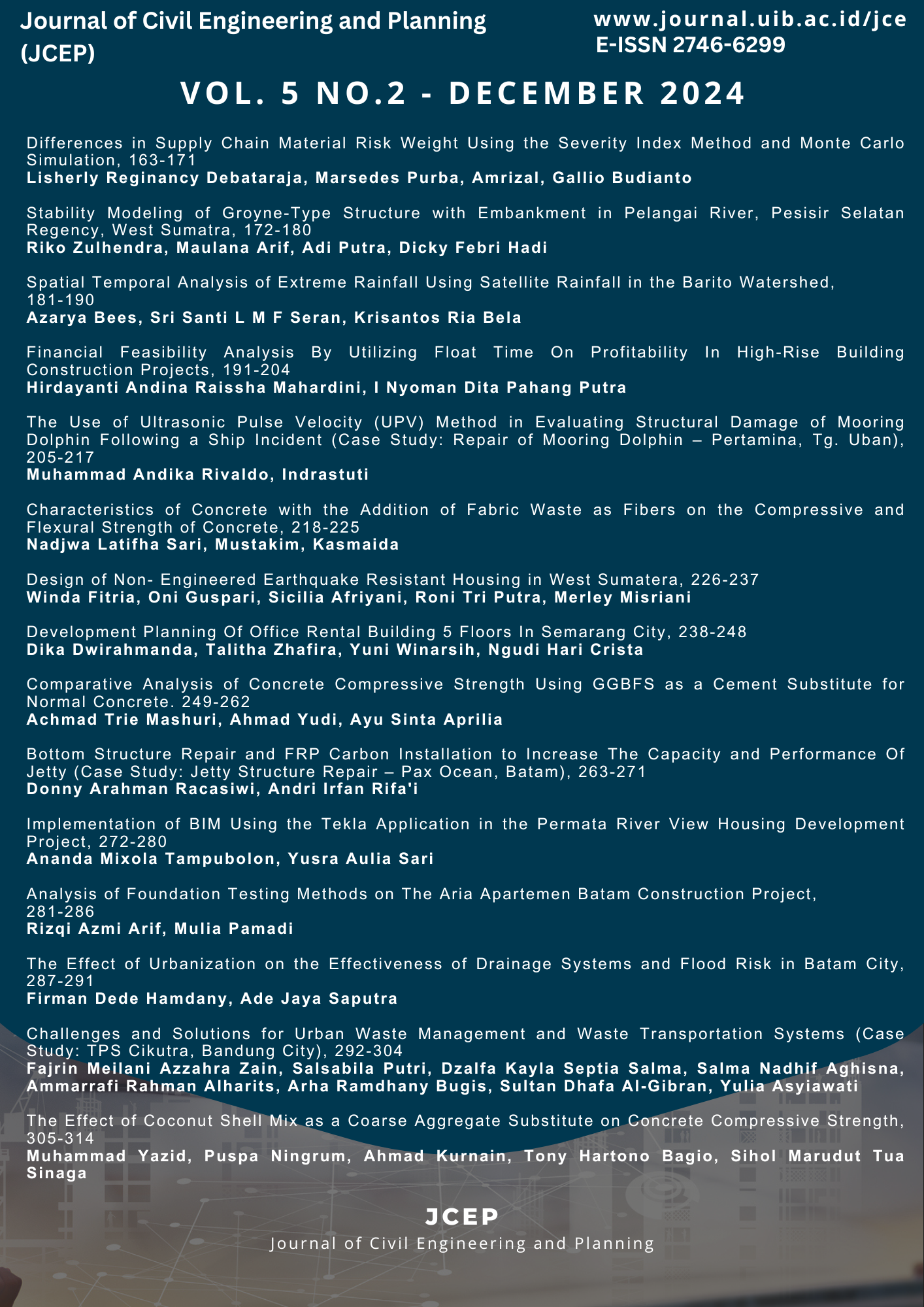Characteristics of Concrete with the Addition of Fabric Waste as Fibers on the Compressive and Flexural Strength of Concrete
DOI:
https://doi.org/10.37253/jcep.v5i2.9805Keywords:
kuat terkan,kuat lentur,limbah kainAbstract
Mineral waste, particularly from synthetic fabrics, is challenging to manage due to its non-decomposable nature and inability to compost. This waste accumulates, posing environmental risks. As a solution, utilizing fabric waste in concrete mixtures has been proposed. This study aims to evaluate the compressive strength and stiffness of concrete with added fabric waste and identify the optimal percentage of waste as fiber reinforcement. The research employed experimental methods following the SNI-03-2834-2000 standard at the Structural Materials Laboratory, Muhammadiyah University of Parepare, conducted from February to March 2024. Results showed that on the 28th day, adding 5% table iron increased concrete compressive strength to 9.91 MPa, while increasing it to 10% reduced strength to 0.66 MPa. Adding 10% cotton fabric improved compressive strength by 2.23 MPa and flexural strength by 3.822 MPa. The findings suggest that fabric waste, combined with vibration and wire reinforcement, enhances concrete performance. The optimal results were observed with 5% boron material for compressive strength and 10% cotton material for flexural strength, demonstrating the potential of textile waste as an effective concrete mixture component. This study highlights the dual benefits of waste reduction and material enhancement, contributing to environmental sustainability and advancing concrete technology.
Downloads
References
Amna, K., Wesli, W., & Hamzani, H. (2017). Pengaruh Penambahan Serat Tandan Sawit Terhadap Kuat Tekan Dan Kuat Lentur Beton. Teras Jurnal : Jurnal Teknik Sipil, 4(2), 11–20. https://doi.org/10.29103/tj.v4i2.19
Andani, A. D. I. Y. (2023). Pengaruh pemanfaatan limbah tekstil kain perca pada material pembuatan beton mutu rendah (k-225) skripsi.
BSN. (1974). Cara uji kuat tekan beton dengan benda uji silinder. Badan Standarisasi Nasional, Jakarta. https://www.academia.edu/download/57886647/SNI-1974-2011-.pdf
Catur, A. D., Setyawan, P. D., Padang, Y. A., Nuarsa, I. M., & Triadi, A. A. A. (2022). Kuat lentur dan berat jenis beton ringan selular diperkuat serat kain pakaian bekas. Dinamika Teknik Mesin, 12(1), 8. https://doi.org/10.29303/dtm.v12i1.497
Jaya, D. P. (2022). Pengaruh penambahan limbah kain pakaian bekas terhadap kekuatan tekan dan bending dari komposit foam beton ringan.
Maghfira, M., Mustakim, M., & Muis, A. (2024). Stabilitas Paving Block Menggunakan Plastik PET (Polyethylene Terephthalate) Dengan Tambahan Serat Bendrat. Jurnal Karajata Engineering, 4(1), 37–43. https://doi.org/10.31850/karajata.v4i1.3110
Malino, L., Wallah, S. E., & Handono, D. B. (2019). Pemeriksaan Kuat Tekan Dan Kuat Tarik Lentur Beton Serat Kawat Bendrat Yang Ditekuk Dengan Variasi Sudut Berbeda. Jurnal Sipil Statik, 7(Juni), 711–722.
Putra, A. M., & Noorhidana, V. A. (2020). 1366-6684-1-Pb. 8(2), 367–384.
Risdianto, Y., & Tobing, G. R. L. (2019). Pengaruh Penambahan Serat Sabut Kelapa (Coconut Fiber) Terhadap Kuat Tekan , Kuat Tarik Belah Dan Kuat Lentur Pada Beton. Rekayasa Teknik Sipil, 2(2), 1–8.
Winarno, E. (2021). Analisa subtitusi limbah karbit serta penambahan serat limbah kain pada kuat tekan beton. 11(3), 1–14.
Downloads
Published
Issue
Section
License
Copyright (c) 2024 nadjwa nadjwa latifha, mustakim mustakim, kasmaida kasmaida

This work is licensed under a Creative Commons Attribution 4.0 International License.



_0011.jpg)









